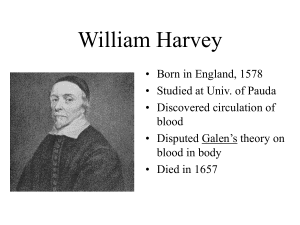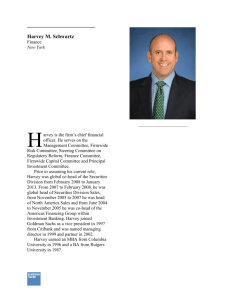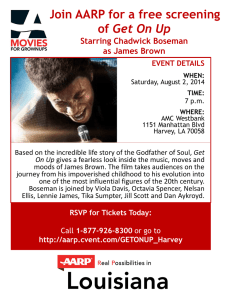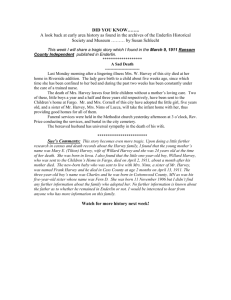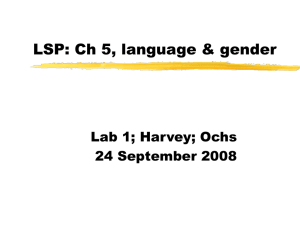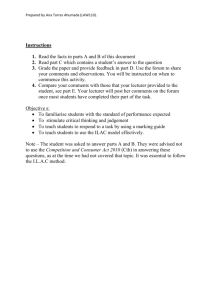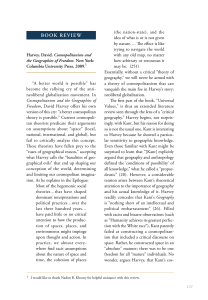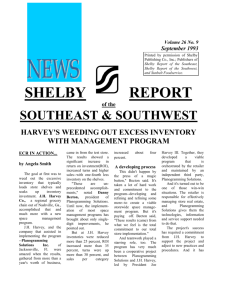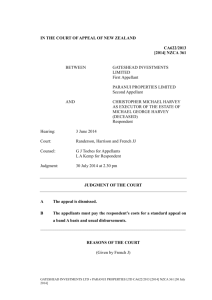30:725:424:01 History of Pharmacy Class Outline
advertisement
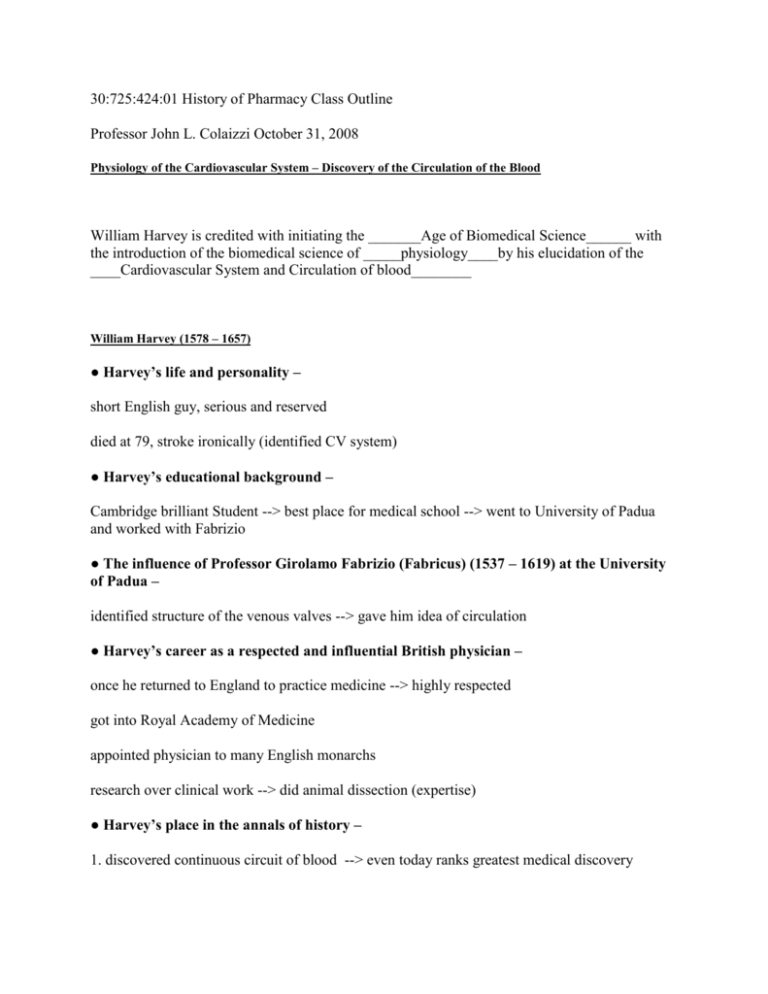
30:725:424:01 History of Pharmacy Class Outline Professor John L. Colaizzi October 31, 2008 Physiology of the Cardiovascular System – Discovery of the Circulation of the Blood William Harvey is credited with initiating the _______Age of Biomedical Science______ with the introduction of the biomedical science of _____physiology____by his elucidation of the ____Cardiovascular System and Circulation of blood________ William Harvey (1578 – 1657) ● Harvey’s life and personality – short English guy, serious and reserved died at 79, stroke ironically (identified CV system) ● Harvey’s educational background – Cambridge brilliant Student --> best place for medical school --> went to University of Padua and worked with Fabrizio ● The influence of Professor Girolamo Fabrizio (Fabricus) (1537 – 1619) at the University of Padua – identified structure of the venous valves --> gave him idea of circulation ● Harvey’s career as a respected and influential British physician – once he returned to England to practice medicine --> highly respected got into Royal Academy of Medicine appointed physician to many English monarchs research over clinical work --> did animal dissection (expertise) ● Harvey’s place in the annals of history – 1. discovered continuous circuit of blood --> even today ranks greatest medical discovery 2. Defined first system of physiology 3. introduced scientific age of medicine ● Harvey’s meticulous research and transformational discovery – ▪ 17 years of study and preparation – to come up with publishing ideas of circulation knew of controversies of the past that would arise so, slowly introduced idea held out lectured, before publication (1611-1628), early to middle 30s when he found whole circulation of blood) ▪ Harvey’s brilliant publication: Exercitatio Anatomica de Motu Cordis et Sanguinibus in Animalibus – anatomical experiments on the motion of heart and blood in animals published year 1628 in his 50s 72 pages, some consider most brilliant medical publication ever! ▪ The incontrovertible proof presented by the de Motu Cordis – people accepted it despite how it went against Galen and others ideas ● The general outline of de Motu Cordis – ▪ Auricles, Ventricles, Veins, Arteries -->chambers of the heart, detailed discovery of anatomy ▪ The Vena Cava – 2 main veins by which blood enters RA ▪ The Aorta –major vessel, main artery transported LV --> aorta , blood out of the heart ▪ The valves of the blood vessels –unidirectional flow ▪ The heart’s only function –pump ▪ The Pulmonary (“lesser”) Circulation – clearest explanation of pulmonary circulation, did not give credit to anyone (Galen, Servito, Columbo) ● The Conclusion of the de Motu Cordis: “That there may be a motion, as it were in a circle……………….” The Aftermath of Harvey’s Discovery – ● Bloodletting and Leeches – ▪ General –stimulated interest and realized blood was important ▪ Critics: Johannes Van Helmont (17th century) and Pierre Louis (19th century) did not fit his iatrochemistry (body is chemical factory) Pierre Louis --> biostatistics --> no statistical evidence bloodletting is valid ▪ Current status of bloodletting, phlebotomy, venepuncture blood letting no longer practiced except polycythemia vera (too many RBCs) phlebotomy used 1. gain vascular access (needle, catheter) 2. TDM --> therapeutic drug monitoring ● Blood Transfusions – ▪ Early misconceptions as a result of Harvey’s work – concerning mental illness --> was thought that draining blood of insane and putting the blood of sane would cure mental illness --> ▪ Early experiments and lack of success – disastrous results, blood transfusions came back 20th century ▪ Karl Landsteiner (1860 – 1943) (Austrian born American immunologist) – came up with idea of distinct blood groups, based on antigens on RBC hospital --> pt will die if given different blood type ● The parenteral Route of Administration▪ Sir Christopher Wren (1632 – 1723) and his experiments with the IV Route – hooked the bladder to a quill put in slurry of opium --> injected into vein of dog -->squeezed balloon to get mix into dog--> anesthetisized --> IV injection Wren first tried to do experiments with IV route, stimulated by Harvey's work tried IV injections in humans not resurrected until late 19th century ▪ Reasons for the disastrous results with IV administration during the late 17th and early 18th centuries – was not resurrected til 19th century 1. did not have true physical checmical solutions, no soluble salts, only opium compoudns 2. no understanding of asepsis/sterility/microbes 3. poor equipment: bladder and quill 4. did not understand pyrogens (cause fever) ▪ Gradual resumption of IV and other forms of parenteral therapy - contributors to the progress: 1796 – Edward Jenner (1749 – 1823) –English Physician, 1st vaccine for smallpox by intradermal injection 1853 - Charles Gabriel Pravaz (1791 – 1853) -->invented hypodermic syringe and needles by SC injection 1855 - Alexander Wood (1817 – 1884) –Scotchmann, first to use SC for morphine 1867 – Joseph Lister (1827 - 1912) –surgery should be done aspetically, aseptic technique, was almost thrown out of medical society, British were offended "dirty hands" 1886 - Stanislaus Limousin (1831- 1887) – The Ampul --> RPh, invented first container to maintain sterility for parenterals 1906 - Paul Ehrlich (1854 – 1945) – Salvarsan --> IV injection for syphilis Americans 1911 - W. Kausch - Parenteral Hydration Solutions -large volume D5W, NSS for hydration and electrolytes 1923 – Florence Seibert (1898 – 1991) - Pyrogens 1967/1968 – Stanley Dudrick - Total Parenteral Nutrution – Surgical Nutrition – American surgeon, hypertonic is >5%. into peripheral veins, central vessel --> hypotonic solution so that vessels would not sclerose with hypertonic solution 1965 -1970 – Clifton Latiolais (1918-1995) – Pharmacy-bases IV Admixtures/Aseptic Technique -->RPhs responsible for sterile solutions Ohio state university came up with it. taught RPhs how to prepare aseptic --> legally require hospital solutions. .
